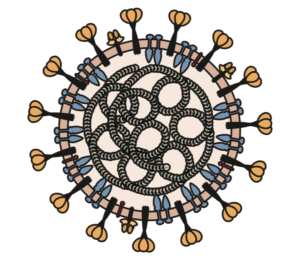

Despite recent proclamations to the contrary by WHO, there is good evidence that individuals who are asymptomatically infected with SARS-CoV-2 can efficiently spread infection to others. The levels of virus and the immune response in asymptomatically infected individuals has not been well studied to understand the infection events taking place. A recent small study provides some clues.
Before describing this study, it’s important to clarify what is meant by a symptom of infection: It is something that can be felt only by the infected individual. In contrast, a sign of infection is something that is measured by someone else. An asymptomatic individual therefore does not feel changes during infection, such as sore throat or shortness of breath. However, an asymptomatic individual might have signs of infection, such as virus detectable by PCR or antibodies or cytokines in the serum.
In February 2020 the Wanzhou CDC carried out a program to identify asymptomatically infected individuals by RT-PCR screening of quarantined close contacts of confirmed infected patients. From this effort, 37 individuals were identified who had no relevant clinical symptoms in the preceding 14 days, but had a positive nucleic acid test (a sign of infection). These asymptomatic patients constituted 20.8% of all patients in that time period in the Wanzhou district. Whether this number is a reflection of the asymptomatic rate in the general population needs to be determined by more extensive serological surveys.
For comparison, 37 sex, age, and comorbidity-matched symptomatic individuals were selected from the same patient cohort.
Measurement of clinical parameters revealed that 3 of the asymptomatic patients had lymphopenia (reduced lymphocyte counts in the blood) and one had thrombocytopenia (low levels of platelets in the blood). Six had elevated levels of a liver enzyme, and 11 had increased levels of C-reactive protein (a blood protein that increases in response to inflammation). CT scans revealed lung abnormalities in 14/21 asymptomatic individuals. In other words, while many of the patients didn’t feel anything related to a respiratory virus infection, viral reproduction was clearly causing signs of infection!
When viral nucleic acid was measured by RT-PCR of nasopharyngeal swabs, shedding of viral RNA was detected from 6-45 days in asymptomatic individuals (median 19 days). In patients with mild symptoms, viral RNA was detected from 9-22 days (median 14 days). While the asymptomatic group appear to shed viral RNA for a longer period of time, further work should be done to determine the time of shedding of infectious virus.
Antibodies to SARS-CoV-2 were measured in asymptomatic and symptomatic groups. IgG levels in the symptomatic group were significantly higher than those in the asymptomatic group.
Elevated concentrations of pro- and anti-inflammatory cytokines were detected in the blood of the symptomatic group compared with the asymptomatic group. In fact, levels of 32 cytokines were similar in the asymptomatic and control (uninfected) group.
In summary, these observations show that SARS-CoV-2 infected asymptomatic patients have a lower antibody and inflammatory response than symptomatic patients and shed viral RNA for a longer period of time. The reduced immune response of asymptomatic individuals may both explain their lack of symptoms and higher virus titer. Nevertheless, these asymptomatic patients had clear signs of infection, including lung abnormalities. I wonder if such studies on ‘asymptomatic’ individuals may include those who are less aware than others of changes to their bodies caused by infection. Most importantly, asymptomatic individuals make it difficult to control an epidemic because they go about their usual lives and in so doing spread infection.

Pingback: Virus and antibodies during asymptomatic SARS-CoV-2 infections – Virology Hub